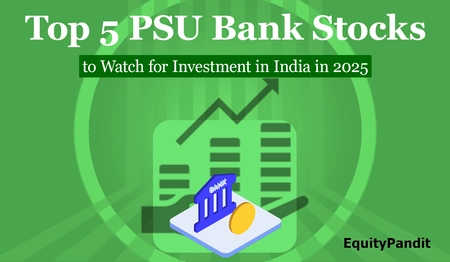Public Sector Undertakings (PSU) Banks in India are financial institutions where the government holds a majority stake (over 50%) through the Ministry of Finance or State Ministries. These banks balance public service with commercial operations, as their shares are listed on stock exchanges.
In Budget 2025, PSU banks emerged as key beneficiaries, reflecting a strong outlook. A reduction in fiscal deficit and borrowing estimates further boosted PSU banks, which hold more government bonds than private banks, supporting their performance.
Top five PSU banks stocks to watch for investment in India in 2025.
| PSU Bank Stock | Market Capitalisation (in Rs. Cr) | Total Assets (in Rs. Cr) | Dividend Yield (%) |
| State Bank of India | 6,89,338 | 67,33,779 | 1.77 |
| Bank of Baroda | 1,19,329 | 16,54,779 | 3.30 |
| Punjab National Bank | 1,10,780 | 15,98,636 | 1.49 |
| Union Bank of India | 94,771 | 14,01,996 | 2.90 |
| Indian Overseas Bank | 78,899 | 3,13,450 | 0.00 |
1. State Bank of India
State Bank of India (SBI), a Fortune 500 company, is India’s largest public sector bank with an asset base of over Rs. 61 trillion. Headquartered in Mumbai, it operates over 22,500 branches, 63,580 ATMs/ADWMs, and 82,900 BC outlets, serving 50 crore customers.
Beyond core banking, SBI has strong subsidiaries, including SBI General Insurance, SBI Life Insurance, SBI Mutual Fund, and SBI Card. With a presence in 29 countries, it continues to innovate and expand, focusing on responsible and sustainable banking.
Positive trends that make you watch for investment in the SBI Stock are as below –
- The stock has risen over 57% in the last 3 years, consistently outperforming the BSE 500.
- Market capitalisation is around Rs. 6,89,338 crore.
- As of Dec 2024, revenue stands at Rs. 1,28,467 crore.
- As of 2024, total assets are valued at Rs. 67,33,779 crore.
- As of 2024, net profit is around Rs. 68,138 crore.
- Dividend yield is approximately 1.77%.
2. Bank of Baroda (BOB)
Established on 20th July, 1908, Bank of Baroda is India’s third-largest public sector bank, headquartered in Vadodara, Gujarat. It operates over 8,200 branches, 10,000 ATMs, 1,200 e-lobbies, and 20,000 Business Correspondents, with a global presence in 20 countries.
Its key subsidiaries include BOB Financial Solutions, BOB Capital Markets, and Baroda Asset Management, along with joint ventures like IndiaFirst Life Insurance and India Infradebt Ltd. The bank also owns 98.57% of The Nainital Bank and sponsors three Regional Rural Banks.
Positive trends that make you watch for investment in the BOB Stock are as below –
- The stock has risen 109.40% in the last 3 years.
- Market capitalisation is around Rs. 1,19,329 crore.
- As of Dec 2024, revenue stands at Rs. 34,676 crore.
- As of 2024, total assets are valued at Rs. 16,54,779 crore.
- As of 2024, net profit is around Rs. 18,410 crore.
- Dividend yield is approximately 3.30%.
3. Punjab National Bank
Punjab National Bank (PNB), India’s second-largest public sector bank, was founded on 12th April, 1895, with the vision of a national bank for Indians. Nationalized in 1969, it remains government-owned.
As of September 2023, PNB had 5,519 domestic branches, 2 international branches, 12,645 ATMs, and 28,782 Business Correspondents, with a Gross Global Business of Rs. 22.51 trillion. Its IFSC Banking Unit in GIFT City, established in April 2022, offers international banking services.
Positive trends that make you watch for investment in the PNB Stock are as below –
- The stock has risen 170.79% in the last 3 years.
- Market capitalisation is around Rs. 1,10,780 crore.
- As of Dec 2024, revenue stands at Rs. 34,752 crore.
- As of 2024, total assets are valued at Rs. 15,98,636 crore.
- As of 2024, net profit is around Rs. 9,157 crore.
- Dividend yield is approximately 1.49%.
4. Union Bank
Union Bank of India, founded on 11th November, 1919, is a leading public sector bank with 74.76% government ownership. Merging with Andhra Bank and Corporation Bank in 2020, it now operates over 8,400 branches, 9,300 ATMs, and 20,000 Business Correspondents across India.
As of 31st March, 2024, the Bank’s total business stood at Rs. 21.26 trillion, with deposits of Rs. 12.21 trillion and advances of Rs. 9.04 trillion. It has international branches in Dubai and Sydney, a London-based subsidiary, and a joint venture in Malaysia. Recognized for digital banking and financial inclusion, it was the first large PSU bank to implement a 100% core banking solution. Its headquarters are in Mumbai’s Nariman Point.
Positive trends that make you watch for investment in the Union Bank Stock are as below –
- The stock has risen 226% in the last 3 years.
- Market capitalisation is around Rs. 94,771 crore.
- As of Dec 2024, revenue stands at Rs. 31,375 crore.
- As of 2024, total assets are valued at Rs. 14,01,996 crore.
- As of 2024, net profit is around Rs. 13,709 crore.
- Dividend yield is approximately 2.90%.
5. Indian Overseas Bank
Indian Overseas Bank (IOB), founded on 10th February, 1937, is a major public sector bank headquartered in Chennai. The Government of India holds a majority stake, ensuring stability and trust.
With over 3,200 branches, 3,400 ATMs, and a strong digital banking presence, IOB serves customers across India. It also has an international footprint with branches in Singapore, Colombo, and Hong Kong. As of 31st March, 2024, the Bank’s total business stood at Rs. 5.5 trillion, driven by its focus on retail, MSME, and agricultural lending.
Committed to innovation and financial inclusion, IOB continues to expand its services while strengthening its position in India’s banking sector.
Positive trends that make you watch for investment in the Indian Overseas Bank Stock are as below –
- The stock has risen 116.88% in the last 3 years.
- Market capitalisation is around Rs. 78,899 crore.
- As of Dec 2024, revenue stands at Rs. 8,409 crore.
- As of 2023, total assets are valued at Rs. 3,13,450 crore.
- As of 2023, net profit is around Rs. 2,104 crore.
- Return on Equity (ROE) is 11.88%.
If you are looking to invest in the stock market but don’t want to spend too much time picking the right stocks, check out Unicorn Signals, The Super App for the Indian Stock Market.
Discover the powerful insights of ‘Ask the Analyst‘ tool for short-term perspective on stocks in the PSU Segment or any other stock that you might have on your radar.
Disclaimer: Investing in the Equity market in India is subject to risks, i.e. the market keeps on fluctuating. This article is purely for educational purpose. The views expressed and data provided here are by Equitypandit’s team. Kindly do not completely depend on the information provided as the risk appetite differs from individual to individual and there are various other factors in the market to determine the factors to invest in the market.
 Live
Live

